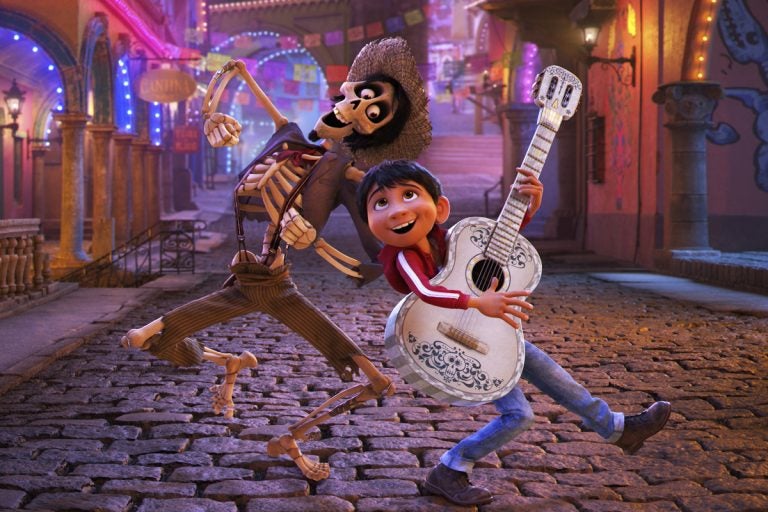If movie franchises rule the box office, what can we learn from the exceptions?
Out of the 31 films to gross at least $100 million last year at North American box offices, 25 were based on some form of IP. But what about those other six?

This image released by Disney Pixar shows a scene from the film "Coco." (Disney/Pixar via AP)
Unless you spent the past few years in self-exile on Ahch-To, you’ve probably noticed a distinct trend in filmmaking toward existing intellectual property — or IP — shaping franchises out of existing stories, universes, and characters that have a built-in fan base.
Don’t worry, this won’t be yet another article about the perils of Hollywood’s overreliance on IP. You could already fill a library with essays bemoaning the constant prevalence of sequels, prequels, remakes, reboots and adaptations in today’s movie theaters.
Out of the 31 films to gross at least $100 million last year at the North American box office, 25 were based on some form of IP. But what about those other six? What can they tell us about cinema and this moment in popular culture?
Generally these six aberrations can fit into three categories: those helmed by auteur directors, whose artistic influence and control is so great that he or she is a seen as the “author” of a movie; those aimed at kids; and those that serve an oft-ignored segment of the audience.
1. Auteurs
Literally thousands of movies have been made about World War II and this one isn’t even the only release last year that deals with the evacuation of Dunkirk. What makes “Dunkirk” special, however, is director Christopher Nolan.
Thanks to his ability to meld blockbuster action and scope with award-caliber storytelling, Nolan is arguably the most successful director working today. Creator of the “Dark Knight Trilogy,” an IP milestone, as well as original hits “Inception” and “Interstellar,” Nolan’s track record sold this WWII thriller.
A stunning and immersive experience, “Dunkirk” was made for Nolan’s preferred format of IMAX. The time-bending narrative also rewards repeat viewings. Suffice it to say, this wasn’t the type of movie you could wait months to watch later on Netflix.
Jordan Peele is the quintessential example of how behind every overnight success, there lies years of hard work. A veteran of Mad TV, he missed out on SNL despite having the best Barack Obama impression in the business. Instead, he co-created the cult Comedy Central show “Key & Peele” with frequent collaborator Keegan Michael-Key. Their 2016 comedy “Keanu” was well-received, but didn’t become the breakout smash admirers hoped.
As a result, no one expected his micro-budget horror flick “Get Out” to make much of a mark. Nonetheless, the film was so impressive and its release date so perfect (it came out in late February, when theaters are normally barren) that it became a cultural phenomenon.
Of course, there was one other reason a horror film dealing with a sinister undercurrent of racism tapped into the zeitgeist: the inauguration of Donald J. Trump. The jarring transition from America’s first black president to a man who questioned that president’s birth certificate made it easier for viewers to buy a story in which a seemingly enlightened white family is not what it seems.
Speaking of geniuses waiting for that crossover hit, July saw the opening of Edgar Wright’s “Baby Driver.” The British-born director always had a hardcore following, but “Scott Pilgrim vs. the World,” his first attempt to appeal to American audiences, was a financial flop. A few years later, he was pushed out of the Marvel Cinematic Universe entry “Ant-Man” over creative differences.
He finally hit it big with this action/comedy in which the music acts as a main character. Another example of a film that needed to be seen on a big screen, “Baby Driver” became the sleeper hit of the summer.
2. For kids (and grown-ups, too!)
Never forget about kids’ films, and never bet against Pixar. The studio that brought us “Toy Story” and “Finding Nemo” continues to produce beloved hits. Beyond branding, however, “Coco” also proved that the country’s growing Latino population was hungry for a story with a Mexican protagonist.
As is a habit with Pixar, this film is likely to be the highest-grossing original release of the year in North America and around the world. In addition to setting records in Mexico, it’s also playing incredibly well in the increasingly important Chinese market. The only issue is that Pixar’s next two films, “Incredibles 2” and “Toy Story 4” are sequels.
On the surface, the success of “The Boss Baby” is due to the fact that it’s another animated movie for young kids. It also doesn’t hurt that it landed in theaters during the spring and, therefore, didn’t face very much competition.
To fully explain this film’s profitability, though, one must look to star Alec Baldwin. The actor found himself in the public eye when he landed the role of Donald Trump for SNL. Trump’s surprise victory, and his eruptions against Baldwin’s impression, only heightened the actor’s profile.
The litany of reviews and commentaries comparing the title character with the commander-in-chief quite likely ginned up interest among adults who took their children to see the film. Remember DreamWorks practically pioneered the “appeal to parents too” strategy with the “Shrek” series. Once again, it paid off for them.
3. Underserved audience
On one level, “Girls Trip” isn’t terribly unique. A group of female friends going on a road trip together after a long time apart is a fairly common concept. What makes this movie stand out is that nearly the entire cast is black.
Despite African-Americans making up a sizable portion of the theater-going audience, films targeted toward African-Americans are few and far between. (With regard to America’s Latino population, “Coco” could also fit into this category.) This is particularly striking given the financial success of such recent films as “Hidden Figures,” “Ride Along” and “Think Like a Man.” Hollywood may well begin to focus more attention on this market as it fights lagging ticket sales. A sequel or another vehicle led by breakout star Tiffany Haddish would be a sign that movie execs are in fact learning from these non-IP outliers.
WHYY is your source for fact-based, in-depth journalism and information. As a nonprofit organization, we rely on financial support from readers like you. Please give today.





